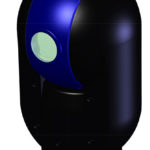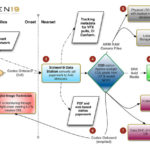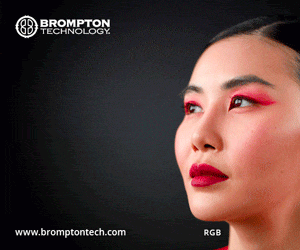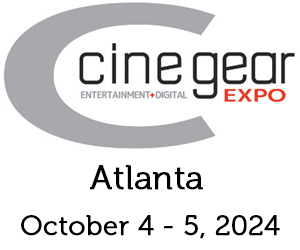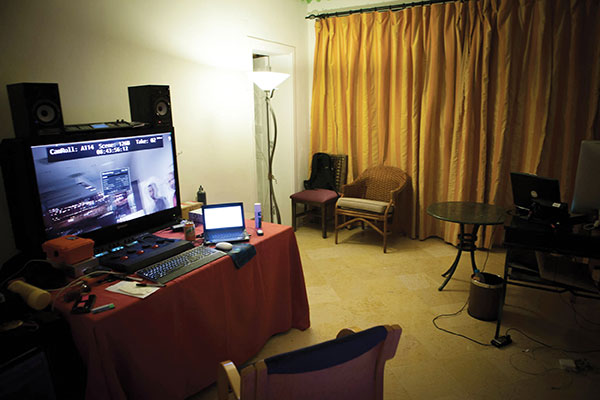
Dark Forces: The Story Of Shooting Zero Dark Thirty
Posted on Mar 15, 2013 by Alex Fice
The last 30 minutes of Zero Dark Thirty tested the Alexa sensor but the lab encouraged Greig to push further.
For the movie Zero Dark Thirty DoP Greig Fraser had his hands full with extreme weather, local protests and custom’s delays but before that he had to decide which camera was going to excel in high sun days and black ‘full action’ nights. MIKE BRENNAN reports.
Zero Dark Thirty’s contrast range goes from the boiling midday sun of Jordan to the zero light of the Navy S.E.A.L raid that caps the movie. It’s like the ultimate camera test scenario. But throw in to that equation a reduced preparation time for the shoot and the large location schedule in India and Jordan, plus the weather, the desert and the complete lack of labs and reduced technical support in the location areas. Add to that the danger of locally arranged protests against the film. That test has suddenly got a lot more difficult.
DP Greig Fraser seemed to take all that in his stride, perhaps why Kathryn Bigelow picked him for her movie, “When you start a movie the world is your oyster as far as cameras are concerned. You’ve got 16mm, 35mm, RED and also Sony F65 at that time. Sony distributed the movie and were keen to get their camera on it. We got a camera and tested it, we also tested anamorphic lenses but we needed a set-up that was bullet proof in that environment. We knew that film would do the job but we were a long way away from Kodak and anything technical.
“We had to choose the most user friendly bullet-proof system that we could and we felt that the Alexa had just been really tested in similarly scenarios, tested in other shows and it was the best digital camera at that point in time. Here’s another reason why the lab was so important for this shoot. If I was using a new digital format and I was pushing the boundaries of that format and I didn’t have at my disposal a lab, the chances are I probably would have been a little more safe, a little bit more predictable. As a DP you can’t afford to screw the thing up. If I’m doing a film and can look at dailies every weekend I become a little bit more adventurous. You can push the boundaries a bit further each time. Having access to that at the end of every day is quite brilliant. It was also quite taxing on the body because you look at hundreds of images a day while you’re shooting and then you come back in to the lab and you’re looking at the same 100 images. It’s quite a hard process. But it means you can push the process a bit, go dark, dark, dark or bright, bright, bright, and you maintain detail or are losing detail when you want to.”
Because the digital lab is made up of desktop computing mainly, it can adjust it’s schedule to suit the production. The lab would work all night to be able to show Greig shots at 7am and also at the endof the day’s shooting when needed.
“I wanted to make sure that my lab was close and that where the digital lab comes in to it – they earned their money in a big way. When you got back to the hotel at the end of the day you can sit down with a colourist, verify the footage and say ‘Hey we were in the sun today and I’m not really comfortable because the actresses’ white blouse was in the sun.’ Meanwhile we would have shadow detail and I wasn’t really sure that I’d got it and kept the highlights. Having access to the Digilab gave you the ability to see what detail you had.”
 DoP Greig Fraser in-car with the Alexa M.
DoP Greig Fraser in-car with the Alexa M.
Greig describes shooting the dark scenes in the movie as like walking a tightrope, choices get narrower and narrower. Sometimes you don’t want too much detail as you want to reveal those things in night vision but normally you want to make sure your exposure is exactly as you want it to be, whether that be over or under exposed.
If you haven’t seen the movie there is also plenty of action in cars, again this is difficult for cameras, “Cars are hell on cameras! You often can’t resolve a white coming in to a car. You might be driving around a corner and you get full sunlight, if you have a sub-standard format skin detail is blown and you lose all your detail. Chances are that the shot is the one the director wants to use in the cut.”
Secrecy
James Eggleton from Digilab mentioned that the hotel room they used for the lab was under a certain amount of secrecy and same was true of the location shoot but Greig wasn’t about to start using DSLRs to minimise the chances of being spotted, “Whilst Canon 5Ds are a brilliant camera they weren’t appropriate for this show. We were a decent sized group of people so it was very hard to keep our heads down without being noticed. Jordan was definitely easier than India in that respect.”
Also shooting close to Black Hawk helicopters and at the extremes of the world was a major worry, “There are some heat issues for some cameras and some dust issues but I’m pleased to say that the Alexas created nothing but golden images. They didn’t break down, and that’s a credit to our ACs as well to make sure there were not dust issues. We had no major issues.”
 Video transmitters from the Assist team were able to send HD video to Kathryn Bigelow’s handheld monitor direct from the Alexa
Video transmitters from the Assist team were able to send HD video to Kathryn Bigelow’s handheld monitor direct from the Alexa
No Accessories
The fourth camera used other than the normal Alexa Plus’ was the Alexa M. Again used for all of the in-car shots and also for other small area scenes, but Greig was adamant that he wasn’t going to crowd the cameras with accessories or even recording devices for freedom of movement, he is a DP who does most of his own shooting, “I wanted to make sure that the cameras were nimble and light weight and so had most of the extra kit including the Codex recording in a bag carried by an assistant. (Digilab designed lightweight injection-molded plastic shells to replace the original aluminum shells of the Codex Datapacks). I need to pick these cameras up and throw them around. I’m a lot more hands on with them and am not one of these DPs who is passed the camera just as we’re about to shoot. I didn’t want to have the Codex anywhere near the camera as well as focus aids, batteries anything that would get in the way. All those things were delegated to a bag that either I would carry or the AC would carry.”
As the mechanics of digital cinematography matures the chances are that external recorders will be the mainstay of the RAW recording side of things and Greig proved this to himself when he was forced to record to the internal cards of the Alexa, “Having an external recorder is not a bad thing, it didn’t hold me up in any way. Very early on I was determined not to have any external devices at all but I managed to see the difference between using ArriRAW on a Codex and recording internally. There is a significant difference. When we travelled from India to Jordan some of our gear got trapped in customs and that included the Codex. The cameras got through and we had to make the shoot times to keep with the schedules. So we had to shoot on cards and when I went to the hotel room that night and looked at the images from the cards they were just no good. I was expecting details in the highlights they didn’t have, detail in the shadows they didn’t have. I couldn’t pick the resolution differences but definitely could see the latitude differences.
“I hate anything external or extraneous but I wouldn’t have done the show without the Codex. You get a remarkably improved image with it.”
The Raid
If you have seen the movie and you are at all interested in camera evolution, it’s quite astounding to watch the darkness of the last 25 minutes or so and realise there is hardly any noise, how did Greig plan for this dark passage? “Kathryn’s quite a purist when it comes to telling a true story. I was quite in synch with that as well which is probably one of the reasons I got the job. We were in synch about how the whole thing should look. She didn’t want it to look like Hollywood lighting and I say that as a very broad term because there are so many ways to make night time in film making. She didn’t want the type of lighting that gives you silhouettes and shapes or any street lights. I’ve done quite a lot of night lighting in the past and it’s quite a challenge to find the best way to do, it’s really hard. How do you justify lighting when there isn’t any in the story? You need very soft shadowless lighting, we had soft boxes quite high up. They don’t have to be that powerful, and need to act almost as if the desert’s star light was shining a path for you.”
The lack of noise in the scenes was of no surprise to Greig as they had made sure the chip wasn’t asked to do things it shouldn’t. “We pushed it right to the edge but again having the lab there looking at the images showed me where my limits were. But there were shots that didn’t work, I won’t tell which ones they are. Not seeing noise or not seeing grain is just a new consciousness.”
The final grade was more of a process of fine tuning as there had been so much work done on the dailies through the lab. “A perfect example of this is you do a wide shot of the house, let’s say the soft boxes are in the air which means the top of the house is brighter than the bottom of the house. That doesn’t happen in the real world because the sky is so high that the bottom would be the same density as the top. In the DI you can window the top of the house and make it match the bottom of the house. It’s those type of things that we took care of in the DI.”
Zero Dark Thirty was the first production to use Codex’s LTFS tape offloader module. Nearly 24 million ArriRAW images were captured over the course of the shoot (about 276 hours), on a shooting average of four hours per day. The Codex Digital Labs were used to archive all of the ArriRAW material to LTO-5 tape in LTFS format. Typically, one Codex was dedicated to archiving the previous day’s material while the other was used to organise and clone the data from the current shooting day. During the busiest sections of the shoot, both labs were either cloning data or archiving to tape 24 hours a day.
The Secret Digital Lab In A Jordanian Hotel
 The lab/hotel room where many nights were spent churning through the RAW files.
The lab/hotel room where many nights were spent churning through the RAW files.
Digilab in London provided the Codex recorders that were used for the movie and also handled the dailies and the near set data management. Their job was to make sure everything was captured, QC’ed for sensor defects and general problems like crew or kit in shot, like you would in a telecine. But the biggest aspect of their job was data management as they were shooting an awful lot, in total it was 276 hours of ArriRAW.
It was known from the outset that many scenes would be shot in very low light conditions, taking full advantage of the sensitivity of the Alexa sensor.
Greig Fraser was keen to record ArriRAW to Codex Onboard recorders to ensure that the maximum amount of image information was preserved for the DI.
On Set
The camera operators needed maximum freedom of movement, so the crew used customised backpacks to which the Codex Onboard recorders, camera batteries, video transmitters (to send a wireless video signal to the director’s handheld monitor), and other accessories could be mounted. The backpacks could be worn by a camera assistant, with only a lightweight cable loom to run to the camera head.
Digilab commissioned lightweight injection-moulded plastic shells for the Codex Datapacks (replacing the original aluminium shells), to use when weight needed to be kept to an absolute minimum.
The Lab
Due to the highly mobile nature of the shoot (much freighting of equipment) it was decided early on that server room equipment like SANs (shared storage) and tape robots were not desirable since they probably wouldn’t endure the rigours of travel. A minimal but robust setup was required.
The Data Lab was kitted out with two Codex DigitalLab-3 systems, six Codex Storage-10 drives, a Colorfront OSD system running on a Mac Pro, and some small SAS RAID systems for Dailies playback storage. The OSD system was connected to a calibrated 42in Dolby PRM4200 reference monitor.
The primary responsibilities of the Lab department were to copy picture data to two separate storage systems, give all clips meaningful names (as per Editorial naming conventions), produce 2x verified LTO tape copies of the data, visually QC all images, sync sound, apply a Dailies grade, and render to Avid DNxHD MXF media.
The Data Lab was staffed by three Digilab technicians who worked shifts, at times covering all 24 hours in order to minimise Diskpack turnaround times.
Most of the shoot was four camera, sometimes splitting into two units. Whenever a splinter unit strayed further afield, one of the lab technicians would follow with a Codex Lab and Storage-10 packs. This allowed Storage-10 packs to be rotated between the two units, with tape archiving, QC and file deliverables being handled at the main base.
Each day the ArriRAW data from recorded Onboard Datapacks was collated to a Codex Storage-10 Diskpack (10TB RAID-3 protected) and to direct-attached SAS storage. Once there were two verified copies, the Onboard Datapack could be cleared and returned to set.
Datapacks were delivered to the Lab in two splits; at lunch break, and again at wrap. This meant that the morning’s material could be graded and be ready to view by the DP and Director on wrap.
Zero Dark Thirty was the first production to use Codex’s LTFS tape offloader module. Almost 24 million ArriRAW images were captured over the course of the shoot (approximately 276 hours), on a shooting average of four hours per day. The Codex Lab systems were used to archive all of this ARRIRAW material to LTO-5 tape in LTFS format.
Typically one Codex Lab machine was dedicated to archiving the previous day’s material while the other was used to organise and clone the data from the current shooting day.
During the busiest sections of the shoot, both Labs were busy either cloning data or archiving to tape 24-hours a day.
Image QC and Dailies grades were applied using the Colorfront OSD system. An ACES colour pipeline was used for the Dailies grade, and the images were viewed on the 42in Dolby monitor.
ArriRAW gave them the flexibility to print up or down during the Dailies sessions, or change colour temperature metadata, as if the material had been shot that way.
System logs from the Codex and Mac machines were sent on a daily basis to the Digilab London office, so that Lab processes (archiving, data verification) could be crosschecked with the LTO tapes that were being shipped back to London. All digital assets were tracked throughout the shoot from the London base.



